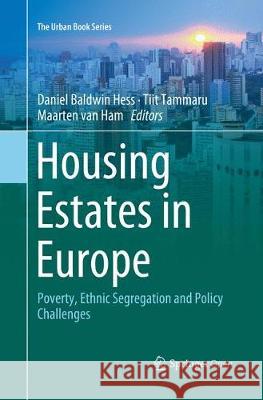Housing Estates in Europe: Poverty, Ethnic Segregation and Policy Challenges » książka



Housing Estates in Europe: Poverty, Ethnic Segregation and Policy Challenges
ISBN-13: 9783030065225 / Angielski / Miękka / 2018 / 424 str.
Housing Estates in Europe: Poverty, Ethnic Segregation and Policy Challenges
ISBN-13: 9783030065225 / Angielski / Miękka / 2018 / 424 str.
(netto: 147,86 VAT: 5%)
Najniższa cena z 30 dni: 154,18 zł
ok. 20 dni roboczych.
Darmowa dostawa!
"I would undoubtedly recommend the book to anyone interested in the legacy of modernist planning." (Adam Radzimski, Eurasian Geography and Economics, March 2, 2020)
"This new book by Hess, Tammaru and Van Ham expands on [an] earlier project by adding more and newer evidence from an even larger number of countries and by identifying successful policies and programs that maintain the quality of these large housing estates as positive places to live for low- and middle-income households. I would recommend this book to academics who work on issues like segregation and concentration of socioeconomically deprived populations in urban space specifically." (Karien Dekker, Journal of Urban Affairs, Vol. 42 (1), 2020)
"I strongly recommend [this book] to housing scholars and practitioners on both sides of the Atlantic. The editors and the publisher, Springer Open, deserve credit for publishing two attractive and useful books that address the breadth and depth of issues related to housing estate revitalization across Europe. The numerous photographs (color as well as black-white) throughout the book helped me to understand changes in the design of European housing estates-the good as well as the bad." (David P. Varady, Geography Research Forum, Vol. 39, 2019)
Introduction: The Role of Large Housing Estates in Past, Present and Future Change in European Cities.- PART 1: Four Thematic Lenses for Viewing the Trajectories of Large Housing Estates.- PART 2: Case Studies of Housing Estates in European Metropolitan Area.- Western Europe (Changing Context, Policies and Estates in the UK: The Birmingham Example / The Socio-economic Evolution of Large Housing Estates in Brussels / Large Housing Estates in a Divided City: Berling's Pallenbauten and Wohnblöcke / Large Housing Estates in the Paris Region: The Local Challenge of Internal Social Mixing in Orly).- Eastern Europe (Persistence or Change: Social and Physical Challenges of Housing Estates in Budapest / Housing Estates in Prague: Long-term Development and Current Situation / Mass Housing Inherited from State Socialism in Tartu, Estonia / Ursynów: Emergence and Evolution of Warsaw's Largest Dormitory Suburb).- Northern Europe (Equity or Net Gains? Tenure Structure, Perceived Social Disorder and Policy Challenges in the Post-WWII Housing Estates of Helsinki region / Large Housing Estates in Stockholm: Do Initial Conditions Matter?).- Southern Europe (Social and Ethnic Transformations of Large Social Housing Estates in Milan: From Modernity to Marginalisation / Large housing Estates in Athens: An Uncommon Form of Social Housing Within a Residual Welfare State.- Conclusion (Assessing the Evidence: Past and Present Trajectories of Europe's Large Housing Estates, and a Comment on the Future).- Index.
1997-2024 DolnySlask.com Agencja Internetowa
KrainaKsiazek.PL - Księgarnia Internetowa









